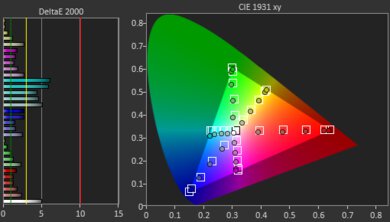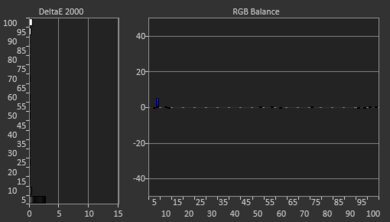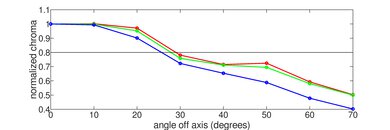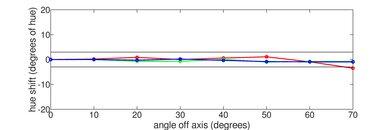The LG UQ9000 is an entry-level 4k TV released as part of LG's 2022 TV lineup. It's their highest-end budget model, sitting below the LG NANO75 2022 and above the LG UQ8000. There's no direct predecessor to this model, but it's very similar to the 2021 LG UP8000 and has been succeeded by the LG UR9000 in 2023. It's pretty bare compared to LG's higher-end models, as it lacks any advanced gaming features and doesn't support Dolby Vision or HDR10+. It runs the 2022 version of LG's proprietary webOS smart interface, which runs well and has a few notable improvements over the 2021 version, and it comes with LG's popular Magic Remote. It's available in many sizes, from 43 to 75 inches.
Our Verdict
The LG UQ9000 is a mediocre TV overall. It's best suited for watching shows or movies in a moderately lit room, as it can't handle a lot of glare due to its limited peak brightness. It's sub-par for use in a dark room, as it has a low contrast ratio, mediocre black uniformity, and no local dimming feature. It has low input lag for a responsive gaming experience, but there are no advanced gaming features like variable refresh rate (VRR) support. Finally, it's good overall for use as a PC monitor, and it can display chroma 4:4:4 properly, but it has some distracting uniformity issues.
- Image remains consistent at a moderate viewing angle.
- Great selection of streaming apps.
- Upscales lower resolution content well.
- Low contrast results in grayish blacks in a dark room.
- Not bright enough to overcome intense glare.
- Noticeable uniformity issues.
The LG UQ9000 is a decent choice for watching TV shows in a bright room. It has a great selection of streaming apps, so you're sure to find your favorite shows, and it upscales lower-resolution content well. It has a decent viewing angle, so the image remains consistent even if you move around or have many people sitting around the TV. Sadly, it can't get very bright, so even though it has good reflection handling, it can't overcome a lot of glare.
- Image remains consistent at a moderate viewing angle.
- Great selection of streaming apps.
- Upscales lower resolution content well.
- Not bright enough to overcome intense glare.
- Noticeable uniformity issues.
The LG UQ9000 is an alright choice for watching sports, especially if you're in a room with some lighting or have a wide seating arrangement. It has a decent viewing angle, so the image remains consistent when watching from the sides, so people can sit around the TV and have a good viewing experience. It also has good reflection handling but isn't very bright, so it can't overcome a lot of glare. Sadly, it has a poor response time, so it's hard to make out fine details in fast action due to blur.
- Image remains consistent at a moderate viewing angle.
- Upscales lower resolution content well.
- Not bright enough to overcome intense glare.
- Poor response time results in blurry motion.
- Noticeable uniformity issues.
The LG UQ9000 delivers a mediocre gaming experience. It has superbly low input lag, which results in an incredibly responsive gaming experience. However, it has a poor response time, so fast motion is blurry, and it lacks any advanced gaming features like variable refresh rate (VRR) support. It doesn't look very good in a dark room, as it has a low contrast ratio and mediocre black uniformity, so it's best suited for gaming in a moderately lit living room.
- Low input lag.
- Upscales lower resolution content well.
- Low contrast results in grayish blacks in a dark room.
- Limited gaming features, no variable refresh rate (VRR) support.
- Poor response time results in blurry motion.
- Noticeable uniformity issues.
Unfortunately, the LG UQ9000 is a disappointing TV for watching movies in HDR in a dark room. Its low contrast ratio and lack of local dimming result in a dull, flat HDR experience, and combined with its low peak brightness in HDR, bright highlights don't stand out. It can't display a wide color gamut, either, and it has poor color volume. On the other hand, it can remove judder from any source, and it displays 4k content perfectly.
- Removes judder from all sources.
- Low contrast results in grayish blacks in a dark room.
- No local dimming.
- Disappointing peak brightness in HDR.
- Can't display a wide color gamut.
- Mediocre black uniformity.
- Noticeable uniformity issues.
Due to its mediocre gaming performance and disappointing HDR experience, the LG UQ9000 isn't a very good choice for gaming in HDR. HDR adds almost nothing, as it has a low contrast ratio, no local dimming, and can't get very bright, so HDR highlights don't stand out. Despite its superbly low input lag, it's limited for gaming, as it has a slow response time and no advanced gaming features, like variable refresh rate (VRR) support.
- Low input lag.
- Low contrast results in grayish blacks in a dark room.
- No local dimming.
- Disappointing peak brightness in HDR.
- Limited gaming features, no variable refresh rate (VRR) support.
- Can't display a wide color gamut.
- Poor response time results in blurry motion.
- Noticeable uniformity issues.
The LG UQ9000 is a good choice as a PC monitor, but there are some limitations. It has a good viewing angle, so the sides of the screen remain consistent if you're sitting close to the screen. It also displays chroma 4:4:4 signals properly, which is essential for clear text from a PC. Its input lag is also truly excellent, so mouse movements are snappy. Sadly, it can't handle a lot of glare very well and has mediocre uniformity, so you'll see some banding and color variation in areas of uniform color, like the white background of your web browser.
- Low input lag.
- Image remains consistent at a moderate viewing angle.
- Chroma 4:4:4 is displayed properly.
- Low contrast results in grayish blacks in a dark room.
- Not bright enough to overcome intense glare.
- Poor response time results in blurry motion.
- Noticeable uniformity issues.
Changelog
- Updated Sep 26, 2025: We uploaded the latest brightness measurements and uniformity photos for the Accelerated Longevity Test.
- Updated Jul 08, 2025: We uploaded the latest brightness measurements and uniformity photos for the Accelerated Longevity Test.
- Updated Apr 17, 2025: We uploaded the latest brightness measurements and uniformity photos for the Accelerated Longevity Test.
- Updated Feb 11, 2025: We uploaded the latest brightness measurements and uniformity photos for the Accelerated Longevity Test.
Check Price
Differences Between Sizes And Variants
We tested the 65-inch LG UQ9000 (65UQ9000PUD), but it's also available in 43, 50, 55, 70 and 75-inch model sizes. Note that the last three letters in the model number (PUD in this case) vary between retailers and individual regions, but there's no difference in performance. There are some differences in performance between sizes, as the 50-inch and 70-inch models use different panel types.
Internationally, this model is available in a few different variants. Some regions carry either the LG UQ90009LA or the LG UQ90003LA, identical to the unit we tested. Most major markets in Europe carry the LG UQ91 instead, which performs the same but has a center-mounted curved stand. That model is also available in an 86-inch size, and a few regions have a 60-inch model as well. The 86-inch model has an IPS panel, while the 60-inch model has a VA panel.
| Size | US Model | Panel Type | Refresh Rate |
|---|---|---|---|
| 43" | LG 43UQ9000PUD | IPS | 60Hz |
| 50" | LG 50UQ9000PUD | VA | 60Hz |
| 55" | LG 55UQ9000PUD | IPS | 60Hz |
| 65" | LG 65UQ9000PUD | IPS | 60Hz |
| 70" | LG 70UQ9000PUD | VA | 120Hz |
| 75" | LG 75UQ9000PUD | IPS | 120Hz |
Our unit was manufactured in March 2022, and you can see the label here.
Popular TV Comparisons
The LG UQ9000 is an entry-level TV outclassed by most of its competition, like the Hisense U6G, Samsung AU8000, and Samsung TU7000. It's an alright choice for watching TV shows or sports in a moderately lit room, but it looks bad in a dark room. Most competing models with VA panels are far better than this TV, even for a bright room. It's been succeeded by the extremely similar LG UR9000. While the newer model gets a bit brighter, has slightly better contrast, and has a faster response time, the LG UQ9000 has better image processing.
For more options, check out our recommendations for the best budget TVs, the best smart TVs, and the best 4k TVs.
Although the LG UQ8000 is a lower-end version of the LG UQ9000, it's slightly better overall. The UQ8000 has better accuracy and better motion handling, but besides those differences, both TVs are very similar.
The LG UR9000 succeeded the LG UQ9000, but the two TVs are extremely similar. The UR9000 has slightly better contrast, gets a bit brighter, and has a faster response time, but the UQ9000 has slightly better processing and is the more accurate TV overall for color and brightness reproduction. These differences are very minor however.
The Samsung TU7000 is better than the LG UQ9000. The Samsung delivers much better picture quality, with a higher contrast ratio and better black uniformity. The Samsung also has a faster response time, so there's less blur behind fast-moving objects. The only real advantage of the LG is that the image remains accurate at a moderate angle, whereas the Samsung is best enjoyed facing it directly in front.
The Samsung AU8000 is much better than the LG UQ9000. The LG UQ9000 uses an IPS panel, which looks bad in a dark room, and it can't get very bright, so it isn't ideal for a bright room, either. The Samsung, on the other hand, looks much better in a dark room, with deep, uniform blacks, and it can handle a bit more glare than the LG. The only advantage of the LG is if you have a wide seating arrangement, as the image remains accurate to a wider angle, but it still looks worse overall.

We buy and test dozens of TVs yearly, taking an objective, data-driven approach to deliver results you can trust. Our testing process is complex, with hundreds of individual tests that take over a week to complete. Most of our tests are done with specially designed test patterns that mimic real content, but we also use the same sources you have at home to ensure our results match the real-world experience. We use two main tools for our testing: a Colorimetry Research CR-100 colorimeter and a CR-250 spectroradiometer.
Test Results

The 'V'-shaped feet are wide-set and support the TV well, but you need a large table if you aren't planning to wall-mount the TV. The feet lift the display about 2.5 inches above the table, so some soundbars won't fit under the screen. Different model sizes come with slightly different feet, but the 50, 55, and 65-inch models have the feet you see in the photos. There's also a variant of this TV, known as the LG UQ91 in Europe, which comes with a curved center-mounted stand instead of feet.
Footprint of the 65-inch stand: 46" x 10.7".
The back of the TV is very plain. There are hooks on the back of the TV to help with cable management. Most of the inputs face to the side, but they're inset into the back of the TV, making it difficult to access if the TV is wall-mounted on a fixed stand. The back of the 43-inch model looks a bit different, with the inputs facing out of the TV's right side.
The LG UQ9000 TV has a decent overall build quality. Most of it is plastic, so it's quite light, and the feet support the TV well, with the TV being quite stable. The back panel has a bit of flex, especially near the inputs, but it isn't an issue. However, there are a few quality control issues, like a gap on the top of the display where the panel meets the border.
Unfortunately, the LG TV has inadequate contrast, so blacks look gray and patchy if you're in a dark room, and dark scenes lack shadow detail. There's also no local dimming feature to improve the appearance of dark scenes.
Note: The 50, 60, and 70-inch variants of this model use a VA panel and have much better contrast, so blacks look darker in a dark room.
The TV doesn't have a local dimming feature, so it doesn't have lighting zone transitions. We still show the TV's performance in this regard to compare with TVs with local dimming.
Unfortunately, the LG UQ9000 has disappointing peak brightness in HDR. Combined with its low contrast ratio and lack of a local dimming feature, bright highlights in HDR content don't stand out. There's no variation in brightness with most scenes, but very small highlights are dimmed considerably.
These measurements are after calibrating the HDR white point with the following settings:
- HDR Picture Mode: Cinema
- Panel Brightness: Max
- Contrast: Max
- Color Temperature: Warm 50
The 'Vivid' Picture Mode with the 'Cool 50' Color Temperature is a bit brighter, reaching a peak of 372 cd/m² with a 10% window.
There's no noticeable difference in brightness between 'Game' Mode and the most accurate HDR settings.
These measurements are after calibrating the HDR white point with the following settings:
- HDR Picture Mode: Game Optimizer
- Panel Brightness: Max
- Contrast: Max
- Color Temperature: Warm 50
The TV's PQ EOTF tracking is excellent, as most scenes are displayed at the brightness level that the content creator intended, although near-black scenes are a bit too bright due to the TV's low contrast ratio. Content mastered at 600 and 1000 nits hard clips when the TV gets close to its peak brightness, leading to a loss of bright detail. Content mastered at 4000 nits doesn't hard clip as severely as content mastered at 600 and 1000 nits, but the roll-off isn't slow enough to truly preserve bright details.
If you find HDR too dark, setting Auto Dynamic Contrast to 'High' with the Color Tone set to 'Cool 5' increases the brightness of most scenes, as shown in this EOTF, but the overall peak brightness of the display is the same.
The LG UQ9000 has just passable brightness in SDR. It's bright enough to overcome a bit of glare, but it isn't recommended for a bright room. On the other hand, there's no variation in brightness with different scenes, which is great.
These measurements are after calibration with the following settings:
- Picture Mode: Expert (Dark Space, Night)
- Panel Brightness: Max
- Color Temperature: Warm 50
If you want the brightest image possible, switching to the 'Vivid' Picture Mode, with Adjust Contrast at 'Max', Auto Dynamic Contrast on 'High' and the Color Temp set to 'Cool 50' results in a noticeably brighter image, reaching a peak of 356 cd/m² with a 10% window.
Unfortunately, the TV has just an okay color gamut. HDR content looks muted because it can't display a wide color gamut. The tone mapping is also very bad with bright scenes, as the TV sacrifices accuracy to push brighter highlights in HDR. In dimmer scenes, the tone mapping is much better:
The TV has poor color volume. Its narrow color gamut in HDR limits it. HDR content looks flat and dull overall, as colors aren't as bright as pure white, and it can't display dark saturated colors well due to the low contrast ratio.
The TV has okay pre-calibration accuracy. The white balance is mediocre, but most colors are represented accurately. Cyan is noticeably off, though, and the color temperature is very cool, giving everything a bluish tint. Gamma is close to the target of 2.2 for a moderately lit room, but very dark scenes are a bit too bright.
The TV has fantastic accuracy after calibrating to the D65 white point. The white balance and color accuracy are both fantastic, and gamma is perfect. The TV was relatively easy to calibrate, but sadly the color temperature is still too cool.
You can see our full calibration settings here.
The LG UQ9000 has mediocre gray uniformity. There are noticeable bars across the screen, which is distracting when watching sports or using it as a PC monitor, or any other time you have large areas of uniform color on the screen. The sides of the screen are also darker than the center.
Unfortunately, the TV has mediocre black uniformity. The entire screen appears blue due to the low contrast ratio, and near-dark scenes are patchy. Unfortunately, there's no local dimming feature to improve this.
Note: The 50, 60, and 70-inch variants of this model use a VA panel and have much better contrast, resulting in better black uniformity.
The TV is a decent choice for a wide seating arrangement, as the image remains consistent when viewed at a moderate angle. Beyond about 30°, a noticeable decrease in brightness causes colors to appear washed out.
Note that the 50, 60, and 70-inch variants of this model use a VA panel and have much worse viewing angles. Those sizes look best when viewed directly in front.
The TV has good reflection handling. It can handle a bit of glare as its semi-gloss finish reduces the intensity of reflections, but due to its limited peak brightness, it can't overcome intense glare in a bright room.
The TV has very good HDR gradient handling. There's significant banding in dark grays and noticeable banding in bright greens, but other color gradients look great.
Most sizes of the LG UQ9000 use an IPS panel. The RGB subpixel layout helps ensure text from a PC is clear and easy to read. The 50, 60, and 70-inch variants use VA panels, which likely have BGR subpixel layouts, which causes text clarity issues when used as a PC monitor.
Sadly, the TV has a poor response time. Most transitions are slow, resulting in a long blur trail behind fast-moving objects. The low-frequency flicker of the backlight also causes a double image to appear, so this isn't ideal for fast-paced action gaming or sports.
The TV doesn't have an optional backlight strobing feature, commonly known as black frame insertion (BFI). The backlight always flickers at 120Hz, reducing the appearance of persistence blur, but introducing a distracting double image.
Thanks to this TV's slow response time, there's very little stutter when watching low frame rate content, like movies.
The TV can remove judder from any source, which is great. It ensures a clear and smooth movie-watching experience.
Unfortunately, this TV doesn't support advanced gaming features like variable refresh rate technology (VRR), and most sizes are limited to a 60Hz refresh rate. The 70 and 75-inch models have a 120Hz refresh rate but still don't support VRR.
The TV has incredibly low input lag, resulting in a responsive gaming or desktop experience.
The TV supports most common formats, but only at 60Hz on model sizes smaller than 70". Chroma 4:4:4 signals are displayed properly with all supported formats, essential for clear text from a PC, but you must set the input label to 'PC'.
The LG UQ90 can't take full advantage of the PS5. Model sizes below 70" don't support high refresh rate gaming at 120Hz, and none of the sizes support variable refresh rate (VRR). On the other hand, when you start playing a game, it automatically switches to the low latency 'Game' mode, so you don't have to worry about changing settings when gaming.
The LG UQ90 can't fully exploit the Xbox Series X|S. Model sizes below 70" don't support high refresh rate gaming at 120Hz, and none of the sizes support variable refresh rate (VRR). On the other hand, when you start playing a game, it automatically switches to the low latency 'Game' mode, so you don't have to worry about changing settings when gaming.
Sadly, this TV is limited to HDMI 2.0 bandwidth, and unlike LG's higher-end TVs, it doesn't support Dolby Vision or HDR10+, so you're limited to HDR10. It doesn't change much overall, as this TV can't display HDR well anyway.
Unfortunately, this TV doesn't support DTS formats, which is disappointing as many Blu-rays use this format for their main audio track. If you plan on using the TV with a UHD Blu-ray player, connect the audio from your player to your home theater system instead of using eARC.
The TV has an okay frequency response. Like most TVs, the low-frequency extension (LFE) is very high, so it has very little bass and very little thump or rumble. Above the LFE, the frequency response is well-balanced at moderate listening levels, so dialogue is clear and not lost in the background. There's a bit more compression at max volume, especially in the mid and high-treble range.
This TV has decent overall distortion performance. There's relatively little distortion in the mid to treble range, where most people will notice it. Even at max volume, there's very little total distortion.
The TV runs the 2022 version of LG's webOS proprietary smart interface. The interface is fast and easy to use, and it supports user profiles, so you can customize the home page for different users.
This TV comes with the same LG Magic Remote found on high-end LG TVs, like the LG C2 OLED. You can use the remote like a pointer, making it easy to navigate through menus. It also supports voice control, which works well. You can use voice commands to change inputs, open apps, search within apps for content, and even adjust basic settings.




















































